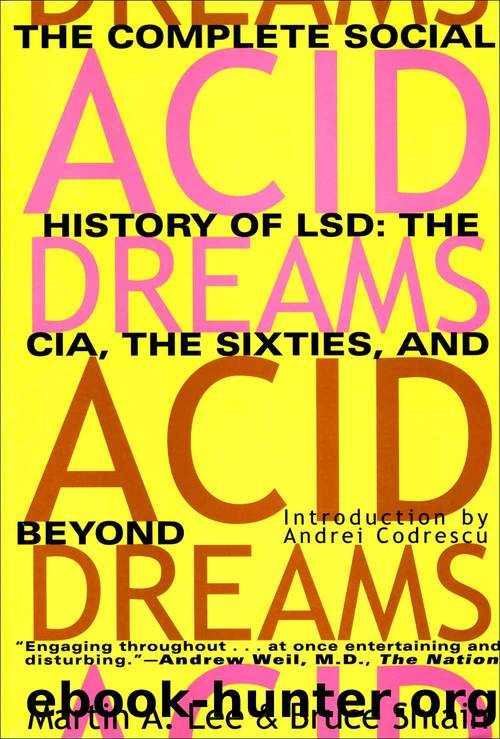Acid Dreams: The Complete Social History of LSD: The CIA, the Sixties, and Beyond by Martin A. Lee & Bruce Shlain

Author:Martin A. Lee & Bruce Shlain [Lee, Martin A.]
Language: eng
Format: mobi
Publisher: Grove/Atlantic, Inc.
Published: 2007-12-01T00:00:00+00:00
The Great Summer Dropout
Nineteen sixty-seven was a year of stark contrasts. Americaâs war against the Vietnamese had swollen into a disaster, provoking disgust and condemnation throughout the world. The black ghettos of Detroit and Newark exploded in the summer heat while Aretha Franklin belted out her anthem for women and oppressed minorities: âAll I want is a little respect. . .â Yet it was also a moment of highflying and heretofore unimagined optimism as the youth movement reached a dazzling apogee. (Time magazine gave its Man of the Year award in 1967 to âanyone under twenty-five.â) Nowhere was the upbeat sentiment of these turbulent times better expressed than by the Beatles, who embodied in their music and personalities the very principle of change itself.
The Beatles were the foremost lyric spokesmen for an entire generation; millions worshiped their verse as holy writ. Their songs were synchronous with the emotional excitement surrounding Haight-Ashbury. The Beatles were a symbol of the communal group that could accomplish anything, and their unprecedented success fueled the optimism of the times in countless ways. Just before the Great Summer Dropout, the Beatles gave the blossoming psychedelic subculture a stunning musical benediction with their release, in June 1967, of the album Sgt. Pepperâs Lonely Hearts Club Band. Later that month they supplied an anthem for the advocates of flower power, âAll You Need Is Love,â in the first live international satellite broadcast, to an estimated audience of seven hundred million people. âI declare,â stated Timothy Leary, âthat the Beatles are mutants. Prototypes of evolutionary agents sent by God with a mysterious power to create a new speciesâa young race of laughing free men. . . . They are the wisest, holiest, most effective avatars the human race has ever produced.â
In their early days the Beatles had popped uppers and downers to keep pace with the rigors of the late-night performing circuit in the bars of Hamburg, Germany. They took whatever was aroundâFrench blues, purple hearts, and the âyellow submarinesâ immortalized in their âchildrenâs songâ of the same name. It wasnât until 1964, after they broke through to rock stardom, that they tried marijuana. The Fab Four got their first whiff of the wacky weed when John Lennon smoked a joint with Bob Dylan at Londonâs Heathrow Airport. It was a happy high, and from then on the Beatles spent much of their time together stoned.
In early 1965 Lennon and his wife, Cynthia, went to dinner with George Harrison at a friendâs. The host slipped a couple of sugar cubes of LSD into their after-dinner coffee, and things got a little barmy when they left. Cynthia remembered it as an ordeal. âJohn was crying and banging his head against the wall. I tried to make myself sick, and couldnât. I tried to go to sleep, and couldnât. It was like a nightmare that wouldnât stop, whatever you did. None of us got over it for about three days.â For John the experience was equally terrifying. âWe didnât know what was going on,â he recalled.
Download
This site does not store any files on its server. We only index and link to content provided by other sites. Please contact the content providers to delete copyright contents if any and email us, we'll remove relevant links or contents immediately.
| Africa | Americas |
| Arctic & Antarctica | Asia |
| Australia & Oceania | Europe |
| Middle East | Russia |
| United States | World |
| Ancient Civilizations | Military |
| Historical Study & Educational Resources |
Never by Ken Follett(2880)
The Man Who Died Twice by Richard Osman(2299)
Machine Learning at Scale with H2O by Gregory Keys | David Whiting(2291)
Fairy Tale by Stephen King(2069)
Will by Will Smith(2042)
Rationality by Steven Pinker(1765)
The Dawn of Everything: A New History of Humanity by David Graeber & David Wengrow(1571)
The Dark Hours by Michael Connelly(1570)
Principles for Dealing With the Changing World Order: Why Nations Succeed and Fail by Ray Dalio(1373)
Friends, Lovers, and the Big Terrible Thing by Matthew Perry(1327)
A Short History of War by Jeremy Black(1300)
HBR's 10 Must Reads 2022 by Harvard Business Review(1256)
Go Tell the Bees That I Am Gone by Diana Gabaldon(1234)
Can't Hurt Me: Master Your Mind and Defy the Odds - Clean Edition by David Goggins(1227)
515945210 by Unknown(1208)
Fear No Evil by James Patterson(1109)
443319537 by Unknown(1072)
Works by Richard Wright(1018)
Going There by Katie Couric(991)
